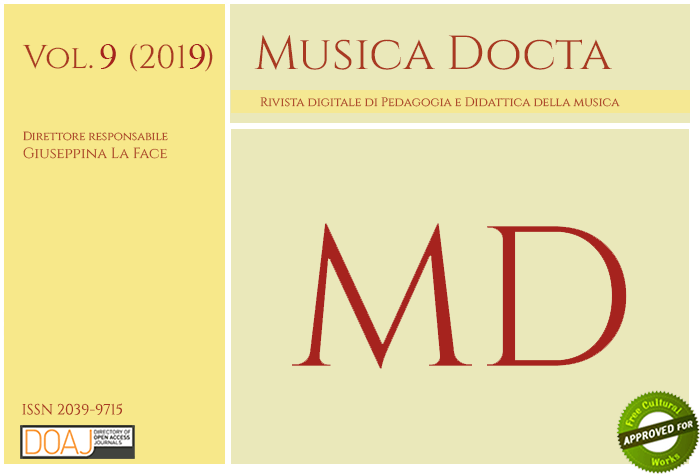Teaching Humanities and Science through Music in Primary Education
DOI:
https://doi.org/10.6092/issn.2039-9715/10177Keywords:
Primary School, Aesthetic Education, Cross-disciplinary TeachingAbstract
Since the 1960s “aesthetic education” has heavily informed American pedagogy of music from primary school to college, as pointed out by philosophers of education like Bennett Reimer and Philip Alperson. Aesthetic education, originally grounded on Hanslick’s idea of absolute music, generated a strict formalist approach to teaching, which made it difficult for teachers to use music as part of a cross-disciplinary educational context, resulting in the isolation of music from the rest of the curriculum. At the root of the problem is what Wayne Bowman identifies as the “tremendous difference between educating in and educating through music.” In 2015 Pierpaolo Polzonetti offered a seminar on “Teaching through Opera,” directed to pre-college teachers of different disciplines, encouraging them to use opera as a way to educate students in a variety of skills and seek knowledge across the curriculum. Maggie Youngblood, a primary-school music teacher who attended the workshop, continued to experiment and collaborate with Polzonetti to educate both in music and through music. Their joint contribution shows how this is another false dichotomy, like the one denounced by Giuseppina La Face between making music and listening to music (between “far musica” and “ascoltare”). Both dichotomies are products of ideological biases that we believe should be dismantled in order to promote active teaching, as opposed to passive acceptance of abstract pedagogical tenets.
Downloads
Published
How to Cite
Issue
Section
License
Copyright (c) 2019 Pierpaolo Polzonetti, Maggie Youngblood
The copyrights of all the texts on this journal belong to the respective authors without restrictions.
This journal is licensed under a Creative Commons Attribution Share-Alike 4.0 International License (full legal code).
See also our Open Access Policy.
Metadata
All the metadata of the published material is released in the public domain and may be used by anyone free of charge. This includes references.
Metadata — including references — may be re-used in any medium without prior permission for both not-for-profit and for-profit purposes. We kindly ask users to provide a link to the original metadata record.






